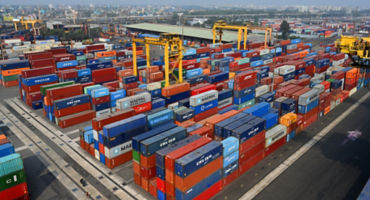- Macro Strategist
Skip to main content
- Funds
- Capabilities
- Insights
- About Us
Asset classes
Hong Kong (香港), Individual
Changechevron_rightThe views expressed are those of the authors at the time of writing. Other teams may hold different views and make different investment decisions. The value of your investment may become worth more or less than at the time of original investment. While any third-party data used is considered reliable, its accuracy is not guaranteed.
My initial assessment of the sweeping tariffs the US presidential administration announced on 2 April is that they appear to be genuinely groundbreaking with potentially far-reaching consequences for financial risk assets, but I want to start by emphasising again how much could change. The extent of the US trading partners’ countermeasures — at time of writing, China has already announced a 34% tariff on all US imports — and the US administration’s tolerance levels for negative blowback in particular could alter the trajectory over the near and longer term. However, what we know is that the outlook is bad for growth, from both a US and global perspective, and markets have reacted accordingly. We see a clear risk-off move, with equities going down and bond rallying. However, what is interesting is that the US dollar is not benefiting from its traditional safe-haven status and rather than rallying, as you would expect, it is doing the opposite by falling against most currencies.
This could be a tentative sign that global investors may be reconsidering how they view the US. After all, why are so many of the world’s assets parked there? In my view, it is because the world’s largest economy offered growth, return and liquidity but also safety and credibility. Tariffs don't only hit growth in the short term; they also change how international investors think about what the US has to offer. How the US Federal Reserve (Fed) responds could be a critical part of this changing investor perception. I think that tariffs are putting the Fed in a difficult position. The growth shock may put pressure on policymakers to cut rates aggressively but that may raise demand and, with it, the impact of tariffs on prices, which would push up inflation.
From a global investor’s perspective, this would imply that the US no longer offers the same protection against rising inflation. If the Fed keeps rates elevated to combat above-target inflation, it will face increased political pressure that could undermine its credibility, which again is a negative for investors. If investors conclude the US is henceforth likely to offer less growth, less return and less safety, we could see a structural reversal of capital flows to the detriment of the US, which would also translate into a significantly lower dollar and a higher risk premium. Much could change — it is not inconceivable, for instance, that President Trump could end up unwinding many of these tariffs — but at the same time, it is hard to negate the sense of rupture. In my opinion, there is a real possibility that we may have witnessed the shotgun start for capital flowing out of the US.
The market reaction to date also suggests a historic shift in its perception of Europe and the euro area, in particular. Hitherto, in the event of a global shock, Europe always tended to be the weak spot, with recurring doubts about credit sustainability forcing the euro area into fiscal tightening. To date, we have not seen a repeat of that scenario. Instead, what we're seeing is a stronger euro and tight sovereign spreads. Investors appear to view Europe in a fundamentally different light since Germany agreed to a structural fiscal loosening. This means that Europe may finally be able to reposition policy pre-emptively and adopt a more pro-growth stance. I think this is an important development for investors to watch, especially if it were to coincide with a return of European investors’ capital from the US.
Expert

InvestorExchange: Tariffs, Treasuries, and taxes — What comes next?
Continue readingInvestorExchange: Credit investing amid today's volatility
Continue readingRapid Fire Questions with Campe Goodman
Continue readingWhy the US dollar’s “crooked smile” could upend asset allocation
Continue readingBy
The yen smile: New economic era upends traditional safe-haven currency relationships
Continue readingBy
Making the most of the new economic era’s bright spots
Continue readingChart in Focus: Patience is power — stay invested through volatility
Continue readingMultiple authors
URL References
Related Insights

InvestorExchange: Tariffs, Treasuries, and taxes — What comes next?
Fixed income portfolio manager Connor Fitzgerald joins host Amar Reganti to discuss the potential effects of tariffs and other fiscal decisions on the bond market.

InvestorExchange: Credit investing amid today's volatility
Host Amar Reganti talks to Campe Goodman about what's next for bond markets and how investors may be able to navigate today's volatility.

Rapid Fire Questions with Campe Goodman
In this edition of “Rapid Fire Questions”, fixed income portfolio manager Campe Goodman shares his views on 4 key questions in this Q&A session.

Why the US dollar’s “crooked smile” could upend asset allocation
Brij Khurana explores the dollar smile theory's impact on asset allocation and foreign investors' strategies amid currency fluctuations.
By

The yen smile: New economic era upends traditional safe-haven currency relationships
Portfolio Manager Sam Hogg discusses the US Dollar Smile Theory and the Japanese yen's safe-haven status in the context of global trade and monetary policy changes.
By

Making the most of the new economic era’s bright spots
Despite uncertainty, there are important factors supporting a more optimistic approach. By focusing on structural trends and considering a wide range of views, investors can position portfolios for positive long-term returns.

Chart in Focus: Patience is power — stay invested through volatility
What does a higher VIX mean? In this edition of Chart in Focus, we explore the historic performance of the global equity market after large bouts of volatility, and the investment implications for equity and fixed income investors amid the US tariff turmoil.
Multiple authors

Four investment perspectives on Trump’s first 100 days
Four of our experts across fixed income and equity share their asset-class level insights on the first 100 days of the current Trump administration and analyze the implications for investors.
Multiple authors

Fiscal versus tariffs: what wins out for Europe?
Just as investors were starting to explore the potential for growth in Europe, Trump’s tariffs landed. To what extent is the case for Europe still intact?

How China can offset the tariff shock
Macro Strategist Johnny Yu details the approaches Beijing could take to offset the tariff shock, from fiscal strategies to potential retaliatory measures to concessions that Washington may welcome.

Flexibility with focus: how to position fixed income for volatility
Portfolio Manager Martin Harvey and Investment Director Marco Giordano explore how a focused use of flexibility can help position fixed income portfolios for volatility.
URL References
Related Insights
DISCLOSURE
This material and its contents may not be reproduced or distributed, in whole or in part, without the express written consent of Wellington Management. This document is intended for information purposes only. It is not an offer or a solicitation by anyone, to subscribe for shares in Wellington Management Funds (Luxembourg) III SICAV (the Fund). Nothing in this document should be interpreted as advice, nor is it a recommendation to buy or sell shares. Investment in the Fund may not be suitable for all investors. Any views expressed are those of the author at the time of writing and are subject to change without notice. Investors should carefully read the Key Facts Statement (KFS), Prospectus, and Hong Kong Covering Document for the Fund and the sub-fund(s) for details, including risk factors, before making an investment decision. Other relevant documents are the annual report (and semi-annual report).
© 2025 Morningstar, Inc. All Rights Reserved. The information contained herein: (1) is proprietary to Morningstar; (2) may not be copied or distributed; and (3) is not warranted to be accurate, complete or timely. Neither Morningstar nor its content providers are responsible for any damages or losses arising from any use of this information. The Overall Morningstar Rating for a fund is derived from a weighted average of the three, five, and ten year (if applicable) ratings, based on risk-adjusted return. Past performance is no guarantee of future results.
Issued by Wellington Management Hong Kong Limited. Investment involves risk. Past performance is not indicative of future performance. This document has not been reviewed by the Securities and Futures Commission of Hong Kong.
We seek to exceed the investment objectives and service expectations of our fund investors and their advisers worldwide
© Copyright 2025 Wellington Management Hong Kong Limited. All rights reserved.
WELLINGTON MANAGEMENT® is a registered service mark of Wellington Group Holdings LLP.
Wellington Management Hong Kong Limited 威靈頓管理香港有限公司 is a private company incorporated with limited liability in Hong Kong, with its address at 17/F Two International Finance Centre, 8 Finance Street, Central, Hong Kong. It is licensed and regulated by the Securities and Futures Commission of Hong Kong with CE Number AJB478.